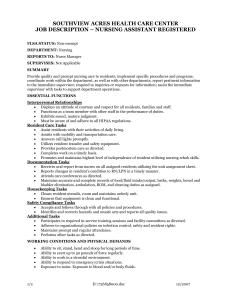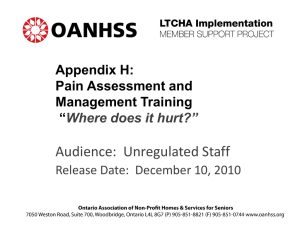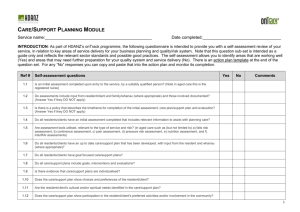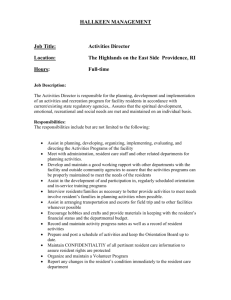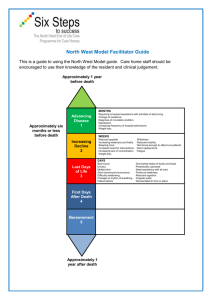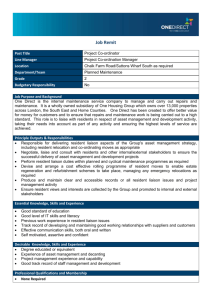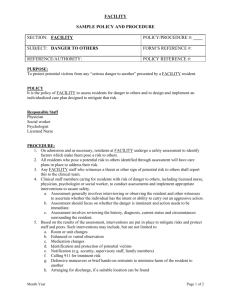2010-06-15_identifying_painnsb
advertisement
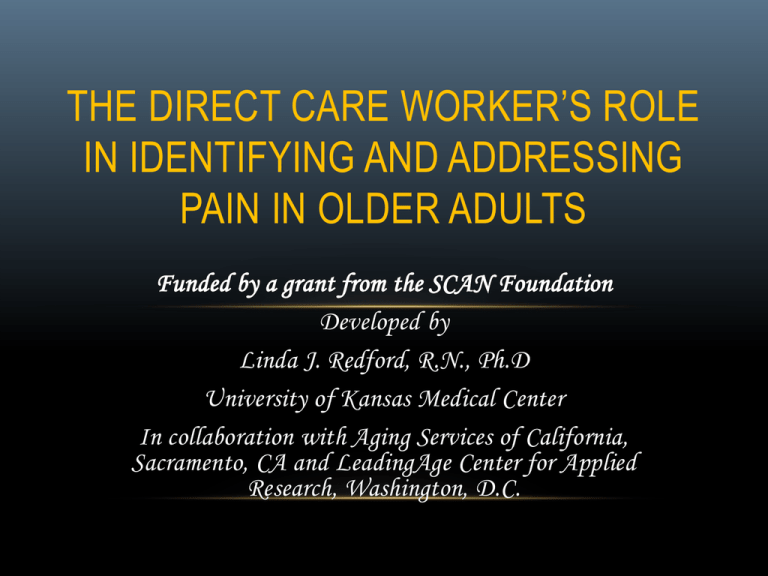
THE DIRECT CARE WORKER’S ROLE IN IDENTIFYING AND ADDRESSING PAIN IN OLDER ADULTS Funded by a grant from the SCAN Foundation Developed by Linda J. Redford, R.N., Ph.D University of Kansas Medical Center In collaboration with Aging Services of California, Sacramento, CA and LeadingAge Center for Applied Research, Washington, D.C. MODULE 1 IDENTIFYING PAIN IN YOUR RESIDENTS AT THE END OF THIS MODULE, YOU WILL BE ABLE TO-• Define pain. • List at least three common causes of pain in older adults. • Identify how common pain is in nursing home residents. • Describe at least four consequences of poorly managed pain for the older person. AT THE END OF THIS MODULE, YOU WILL BE ABLE TO-• State six questions you should ask when conducting a pain assessment on residents who can tell you how they feel. • Describe at least five signs of pain in older adults. HOW COMMON IS PAIN • 45% to 83% of people >65 experience pain • 60% to 70% of nursing home residents have significant pain, one third in constant pain • 32% to 36% of older people in the community have pain Core Curriculum for Pain Management Nursing, 2002 WHAT IS PAIN? Pain is whatever and wherever the sufferer says it is. PAIN DEFINED • A sensation that hurts– causing discomfort, distress, or even agony. • The pain may be from physical causes or from mental anguish. • Pain is difficult to define because it a sensation that is different for each individual. • Perception of pain is influenced by memory, emotions, and expectations. GOALS OF PAIN MANAGEMENT • Improve the person’s ability to do the things (s)he wants to do. • Make the person more comfortable. • Improve the person’s quality of life. • Possibly reduce health care costs. COMMON CAUSES OF PAIN IN OLDER ADULTS • Arthritis & Osteoporosis • Pain and swelling in joints • Back pain • Leg Pain COMMON CAUSES OF PAIN IN OLDER ADULTS • Decreased blood circulation or damage to the nerves in the feet, legs, hands and arms. (Peripheral vascular disease and diabetic neuropathy) COMMON CAUSES OF PAIN IN OLDER ADULTS • Shingles • Headaches CONSEQUENCES OF POORLY CONTROLLED PAIN • Depression • Anger • Poor quality of life • Loss of ability to do daily activities • Impaired relationships with family/friends • Social isolation • Loss of self-esteem ASSESSING PAIN IN A RESIDENT WHO CAN TELL YOU HOW THEY FEEL “Are you having pain or discomfort? or “Are you hurting anywhere?” If the resident says “No”, but you suspect something is wrong, say- “Tell me about how you are feeling.” ASSESSING PAIN If a resident says he/she is having pain/discomfort, you need to ask a series of questions and report the answers to the nurse. WHAT TO ASK ABOUT PAIN • The word WILDA may help you remember what to ask about pain. • Words (How does it feel? This should be the type/quality of pain as stated in the words of the resident) • Intensity (How much does it hurt? Use pain scales to illicit the degree of pain.) • Location • Duration (When did it start? How long does it last?) • Aggravating/Alleviating factors (What makes the pain better or worse?) HOW DOES THE PAIN FEEL? • Aching • Burning • Stabbing HOW DOES THE PAIN FEEL? • Tingling (like pins and needles) • Shoots through a part of the body HOW MUCH DOES IT HURT? • Ask the resident to rate their pain by pointing to the face or responding to the description. No pain Very much pain HOW MUCH DOES IT HURT? • Another approach to determining how badly the person hurts is the numeric scale shown below. WHERE IS THE PAIN? • Ask the resident to tell you or point to where they hurt. • If they say they hurt all over, ask if it is worse in one place. • Ask if the pain is deep in the body or near the outside. DURATION OF THE PAIN • How long has the person been in pain? • Does it come and go or is it constant? • How long does the pain usually last? WHAT MAKES THE PAIN WORSE? • • • • • • Movement Walking Standing Reaching Heat Cold WHAT (IF ANYTHING) MAKES THE PAIN BETTER? • Change in position • Heat, cold, vibration, massage • Certain medication(s) ASSESSING PAIN IN RESIDENTS WHO CANNOT TELL YOU HOW THEY FEEL (OR WILL NOT ADMIT TO HAVING PAIN) NON-VERBAL SIGNS OF PAIN • Confusion • Agitation • Restlessness NON-VERBAL SIGNS OF PAIN • Guarding • Grimacing • Moaning/crying/yell ing • Irritability/ swearing NON-VERBAL SIGNS OF PAIN • Appetite and activity changes • Unusually quiet • Not participating in usual activities HOW YOU CAN HELP WITH PAIN MANAGEMENT WHAT TO DO IF YOU THINK A RESIDENT IS HAVING PAIN• Gather as much information as possible. • Report specific signs of pain to the nurse. • Try simple and safe nondrug strategies- divert attention with conversation, singing, repositioning, touch. • Document what you see. • Document what helps. QUESTIONS? GO TO MODULE 2-NONDRUG THERAPIES


